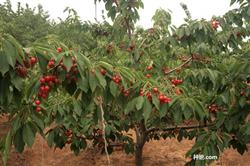How to irrigate the cherry orchard

How to irrigate the cherry orchard? Cherry trees have shallow root distribution and high requirements for soil permeability. Compared with other deciduous fruit trees, they have large leaf area and transpiration, and a large amount of water in the fruit will be lost through the leaves when it is dry and hot. During the period of fruit development, soil drought will cause fruit drop; it is easy to crack fruit in case of rain or irrigation for a long time. Therefore, cherry trees are sensitive to lack of water or too much water in the soil. Cherry orchards need not only irrigation conditions, but also smooth drainage. First, the requirements of pollution-free cherry orchards for irrigation water are clean and non-toxic, in line with the national "quality Standard of farmland Irrigation Water". The main index is that the PH value is 5.5 to 8.5, and the total mercury, total cadmium, total arsenic, total lead, chromium, chloride and cyanide are lower than the national limit standard. In addition, there are total bacteria, coliform bacteria, chemical oxygen consumption and biochemical oxygen consumption and so on. The pollutant index of water quality is divided into three grades, the first level is unpolluted, the second level is clean (within the standard limit), and the third level is pollution (exceeding the warning level). Only the irrigation water that meets the first and second grade standards can produce pollution-free cherries. Second, irrigation of cherry orchards by stages can be divided into pre-flowering water, fruit-stimulating water, postharvest water and frozen water. ① water before flowering. Pre-flowering irrigation, due to low air temperature, it is easy to reduce the ground temperature after irrigation, so the amount of irrigation should be small, with "water over the dry land" as the degree, so as not to affect the root growth. It is best to fill it with water from reservoirs, ponds or wells after being warmed by the sun. ② accelerates fruit juice. From flowering to fruit ripening, both shoots and fruits grow at the same time, which is the most sensitive period to water and the critical period of water demand. When the water content of the main root distribution layer decreases to 12%, it must be irrigated. During this period, irrigation should be frequent and large, usually 2 or 3 times. ③ postharvest water. In places with sufficient water sources, when the weather is dry after fruit harvest, irrigation can be combined with fertilization to give full play to the effect of fertilizer and promote flower bud differentiation. Of course, the above-mentioned irrigation depends on the specific circumstances at that time, such as the need for irrigation when it rains for a long time. ④ frozen water. Proper irrigation from fallen leaves to frozen cherry trees can prevent drought and cold, and it is also beneficial to the growth of cherry trees in early spring. Third, the effect of sprinkler irrigation is good. Sprinkler irrigation can control the amount of spraying water, and spray water evenly and save water, especially for sandy orchards. It can save 60% and 70% of water. Sprinkler irrigation can not only maintain soil looseness, soil aggregate structure and soil fertility, but also regulate microclimate and reduce the harm of low temperature and dry heat to fruit trees. Click to get more cherry planting techniques click to get more fruit planting techniques
- Prev

What should we pay attention to in cherry cultivation?
What should we pay attention to in cherry cultivation? As the saying goes: cherries are delicious and trees are hard to plant. The difficulty of planting trees is mainly determined by the characteristics of cherry roots. The root system of cherry is very shallow, so it is afraid of drought; the root system has a higher respiratory intensity, has more oxygen than other fruit trees, and is most afraid of waterlogging. If the rainy season is a little longer, it will affect the root system.
- Next

Why do cherry leaves curl?
How to fertilize cherry trees scientifically? Cherry is the earliest fruit maturing species in deciduous fruit trees, which is a tree or shrub. The height of the tree is (2 ~ 7) m and the crown diameter is (3 ~ 6) m. (3-6) years began to bear fruit, (7-10) years entered the full fruit period, sustainable (15-20) years, life span of several decades. Key points of fertilization technology:.
Related
- Moge, come on! The staff of the peasant association in the producing area of cantaloupe were frightened when the crowd gathered.
- Causes and Solutions of low Fruit setting rate of Apple
- Symptoms and control measures of passion fruit virus disease
- Fruit growing lesson: how do apple orchards keep high yields?
- Can you build orchards in the mountains? What are the pros and cons?
- How to manage the coloring period of Crisson grape?
- This paper introduces the processing technology of two kinds of fig products.
- How much is a month for retired teachers in rural areas by 2020?
- How can strawberry planting increase sugar content? We should pay attention to management in many aspects.
- What are the cultivation techniques on how to improve the yield of golden fruit?

